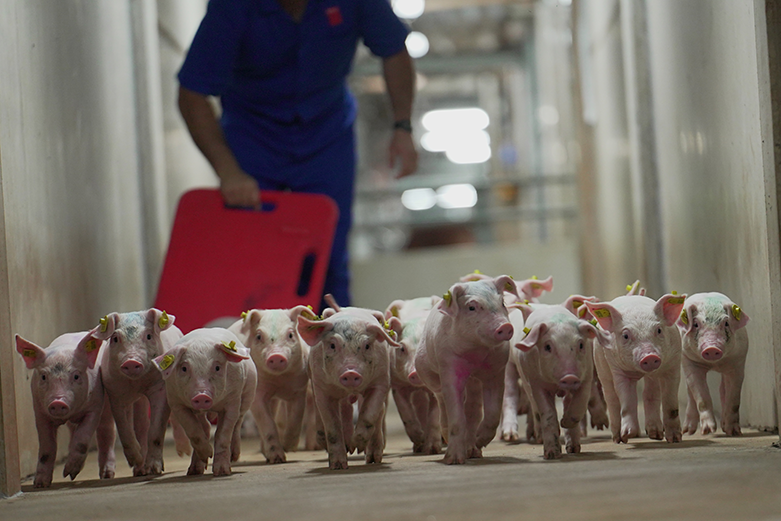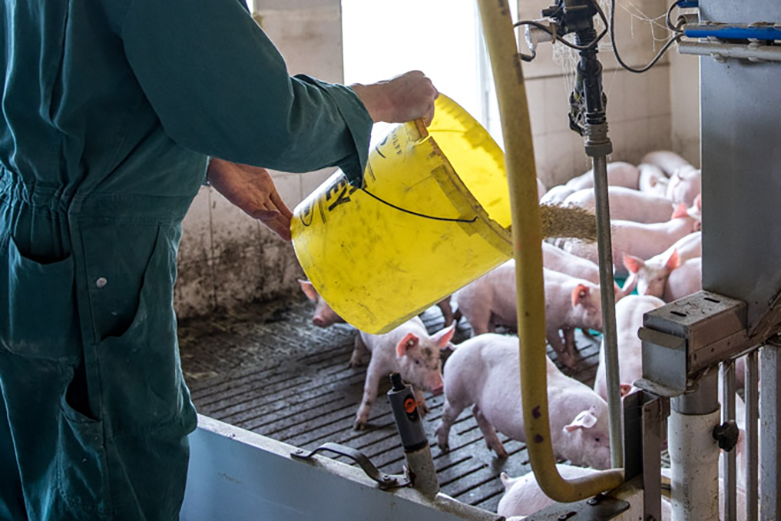WEANING OF PIGS: OPTIMAL MANAGEMENT AND NEW CHALLENGES – an 8-part series
- What happens at weaning
- Objectives at weaning for a sow
- Piglet management around weaning
- Management of piglets after weaning
- Feeding of the sow
- Piglet feeding at weaning
- Age at weaning
- Types of weaning according to the age of the piglet.
The authors:
Emilio Magallón Botaya – Veterinarian specialising in Economics and Pig Production.
Sara Beitia Delgado – Agronomist Engineer – La Almenara Farm
Pablo Magallón Verde – Technical Service PIC
David Roldan Feringan – Veterinarian-Granja La Almenara
Patricia Prieto Martínez – Veterinary Service Inga Food
Images provided by the authors
The feeding of the sow during lactation is possibly one of the most important parts of the day-to-day life on the farm as it has a great impact on the quality of the piglet at weaning and the sow’s own productive development in her next cycle.
Feeding of the sow
At the time of weaning, special attention must be paid to the feeding of both the sow and the piglet. It is a key factor for their immediate future. The positive effect of good management and high feed intake during lactation on the final performance has been demonstrated.
One of the main objectives of the sow during lactation is to reach high feed intakes early in order to achieve good milk production, as this will result in a higher piglet weight at weaning and will allow the sow to finish the lactation period in good body condition. Furthermore, the prolificacy of the following cycle is related to the intake in the previous lactation.
PREMISES FOR ACHIEVING HIGH INTAKES IN SOWS
Achieving high feed intakes during lactation is one of the most difficult and important tasks to achieve on a farm. Some of the premises necessary to achieve these high feed intakes are:
- Body condition of the sow
As shown in figure 1 (and in chapter 2 of this series) there is a direct relationship that shows that the higher the body condition of the sow, i.e., the fatter the sows enter farrowing, the lower their intake capacity.
- Correct environmental regulation
The optimal temperature for sows during lactation is in the range 18-22 °C. For every degree above this temperature the sow should be kept at a comfortable temperature. For every degree of temperature above 22 °C intake is reduced by about 100-150 g/day (figure 2).
Figure 1: Effect of body condition at farrowing on feed intake at farrowing

By consuming less feed, they have more difficulty in weaning litters with high piglet weights. Fat sows lose more Caliper score (body condition) during lactation.
A greater loss of body condition means that prolificacy potential is compromised to a greater extent in the next lactation cycle.
Source: PIC
- Water intake
Feed intake is directly proportional to water intake. There must be a sufficient flow of clean water for the sow to reach high intakes. In this respect, presenting the feed ration moistened with water can lead to an increase in intake of around 10 % compared to a diet offered dry.
- Daylight hours
Intake is higher when there are more daylight hours.
- Number and frequency of feedings
It is advisable to offer at least 3 feedings per day to increase the sow’s intake capacity. It is recommended to try to spread the feedings as much as possible and to choose the times of the day with the lowest temperatures, especially in hot weather.
- Feed palatability
The feed should be in good condition. Rancidity, mould, etc. should be avoided. Good palatability leads to better feed intake and animal welfare.
- Trained personnel
This is the most important factor, as it is the operator who regulates and supervises all factors. Staff who understand the sow and know how to assess her intake capacity to regulate her ration (feed troughs with feed or completely clean after the individual feedings), and who are able to stimulate the sow so that she gets up to eat are essential for optimal feed management in lactation.
- Health status of the sow
A good appetite in animals is a sign of their health. Any disease or inflammatory-infectious process reduces the sow’s intake capacity.
- Design of feeders and drinkers
They should be designed and arranged in such a way that they do not cause excessive difficulty in meeting the animal’s needs, and also so that there is little waste of feed and water.
- Facilities and devices
Electronic feeding systems that allow monitoring and evaluation of the animal’s feeding curve will help us to understand where the sow’s intake capacity is, and to regulate her feeding curve in a more informed and efficient way.
- Sow cycle
The sow’s cycle is an important factor to consider, as we know that gilts normally achieve 10-20% lower intakes on average than adult sows.
Figure 2: Feed intake of lactating sows as a function of ambient temperature. Remaekers, P. (2010)

Number and size of suckling piglets
This is a factor to be taken into account when designing the feeding curve of the animal. Depending on these two parameters, three different scenarios can be found in the farrowing parlour:
- Sow that has achieved high intakes and weans a large, high weight litter (figures 3 and 4).
- This is the ideal situation to look for in all females, in such a way that we will be able to wean many piglets of high quality, and the sow will be well prepared to face her next cycle. The expected weaning-oestrus interval for this sow will be below 6 days.
Figure 3. Sow that has achieved high intakes and weaned a large and heavy litter.

Figure 4: Relationship between feed intake of the sow and feed demand of the litter.

- Sow that does not achieve high intakes and has a very large litter of heavy-weight piglets (figures 5 and 6).
- This is usually the situation with first-litter sows, as these are the sows that are loaded with a high number of large piglets to stimulate the teats/udder. The problem comes when weaning is approaching and the litter is too large with high piglet weights, as the sow can suffer significant losses in body condition. This compromises the sow’s ability to cope with the next cycle.
- In these cases, sows usually show a wean-to-oestrus interval of about 7-12 days and their fertility rate is usually worse. For these cases it may be indicated to wean the litter a few days earlier, with or without supplementing the sow with altrenogest depending on the number of piglets removed.
Figure 5: Sow not achieving high intakes and having a very large litter of fat piglets.

Figure 6: Relationship between feed consumption of the sow and feed demand of the litter.

- Sow achieving high intakes and having a small and/or low litter weight (figures 7 and 8).
- Normally this situation is more typical in adult sows, which are sows capable of reaching high intakes during lactation, and which for some reason have lost an important part of their litter, or the litter has suffered an infectious process (diarrhoea) which has reduced the milk intake capacity of the piglets. This situation, which is more typical in farms that work with longer lactation, can lead to the appearance of oestrus in lactation, which is normally not identified in the farrowing room, and we see that the sows show a “weaning day-estrus” interval of 0-1 days or more than 12 days.
Figure 7: Sow achieving high intakes and having a small and/or low litter weight.

Figure 8: Relationship between feed intake of the sow and feed demand of the litter.

Following the above, when analysing a “weaning day-estrus interval” we could group the sows according to the day they come into oestrus as shown in figure 9.
Figure 9: Wean to estrus intervals in a commercial sow farm

LACTATIONAL ESTRUS
Sometimes if the suckling effect of the piglet is considerably reduced for whatever reason, in-lactation oestrus can occur. This process is more pronounced in some genetic strains, and the problem it causes is that the sows at weaning do not show oestrus because they have already gone through it in lactation.
The main causes of oestrus in lactation are:
- Overfeeding of sows at the end of lactation.
- High percentage of dead piglets, from the 7th day of lactation onwards.
- Partial weaning, especially in the last week of lactation, of more than 2-3 piglets, leaving litters of less than 10/11 piglets.
- Joint lactations: several litters should be brought together before weaning.
- Prolonged lactation in nurse sows, where we give the sow a litter with smaller piglets and less suckling capacity.
- Agalactia problems in sows due to mastitis or other pathological problems.
- Abuse in long lactation of feed supplements: the so-called snacks.
- Prolonged intermittent lactation.
- In general, any process that leads to a drop in milk demand and production.
This series of articles was first published in the professional journal SUIS.



